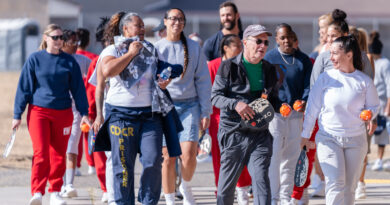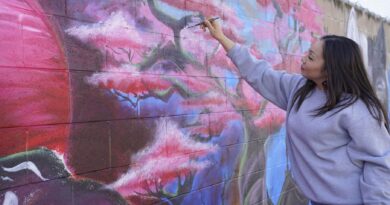GRIP hosts first graduation at CCWF

On Jan. 25, Guiding Rage into Power (GRIP) graduated its first women’s cohort in Central California Women’s Facility (CCWF). Somehow, the gym’s vast interior was made intimate by the presence of guests and a huge Zoom screen filled with the faces of loved ones. Pride was in session: proud graduates, prouder facilitators, and proudest of all, their loved ones in attendance.
Kelly Blackwell, GRIP graduate said, “I was ecstatic and delighted that participants’ family members could share in this moment with us.”
GRIP is a 13-week immersive, intensive program designed to discover root causes of trigger issues and engage the mind in discovering healthy neural pathways. GRIP promotes prosocial behavior, paves over the pitted ruts of roads that lead to nowhere, and ultimately creates peacemakers out of incarcerated people.
“GRIP taught me emotional intelligence, to reframe my thinking, and to persevere through suffering by healing myself,” Francisca Carmona, GRIP graduate, said.
Participants in GRIP, called tribes, commit to 13 weeks of deep self-reflection.
Unified through pain and suffering, like infantrymen in a foxhole, they become bonded through shared trauma in their war against angry false personas while they seek to become their authentic selves.
“As much as I dreaded the small circles, I was able to pour out my heart and find comfort with my tribe members. That was as essential part of my healing journey and transformation,” Lupe Barragan, GRIP graduate, said.
“I know GRIP changes lives because it changed mine,” Rosemary Ndoh, associate director of CDCR said. When asked to encapsulate GRIP in a word, regional manager of GRIP, Andrés Rodriguez, said, “Healing.”
However, Kim Grose Moore, executive director of GRIP, cheated and answered in two words, “Transformation and accountability.”
Rage is not the only defect that can lead to incarceration, though it is a big one because the ways women end up in prison are myriad. And it is not the rage per se; it is the undealt-with, underlying emotions which cause the rage that also contribute to the ranks of the incarcerated, because grief, sadness, loss and trauma can all transmute into rage.
The reductive phrase “hurt people hurt people” gets bandied about and is often used to justify reasons for misdeeds. So, it was gratifying to hear individuals quoted in the GRIP video played during the graduation add the other half of that oft-quoted phrase “healed people heal people.”
The two concepts go together. Damage done requires repairing, and harms caused require healing. And broken individuals doing time and seeking healing require building instead of blaming. That is the essence of GRIP.
Vegas Bray, GRIP graduate said, “GRIP taught me to no longer react when someone hurts me. Instead, I look at the underlying emotions that drive them and I choose to feel empathy for them.”
Our trauma experiences are as unique as fingerprints. Unique responses to individual traumas then result in unique maladaptive coping mechanisms that are also as singular as the individuals affected.
And while it may be easy to dismiss how an individual is coping as ineffective or just plain wrong, it is imperative to accept every individual where they are in their recovery journey.
Diana Jordan, GRIP graduate, said, “Your trauma can be the source of your power, if you choose, and not your downfall.”
The “what” is a known variable –that which the individual did to end up in prison. However, the “why” is often the unknown variable. Solving for “X” requires a deep dive into causative factors and character defects. What mentality allowed them the crime-centric attitude that made bad behavior OK in their minds? In the small circles, all these crucial aspects are addressed.
GRIP is not unlike being dissected like frogs in a high school biology lab, innards picked through and the malignant areas excised, so the end result—when all is put back together— is only the original authentic self.
And every program is only as good as its facilitators and coordinators. It is evident GRIP is a calling and not a job for them.
Formerly incarcerated Teresa “Tree” Moses, GRIP facilitator said, “I found it impossible to forget the ones I left behind; I had to go back and show them what they are capable of.”
GRIP is offered in seven prisons and graduates 500-700 students each year. There have been 1700 GRIP graduates in the state of California, and 800 of those have been released. It costs the state $121,000 to incarcerate one person and just $4000 to fund one GRIP participant.
The number 612 for this year’s graduating tribe is not a number that was chosen at random – it indicates the number of years the graduates have been incarcerated. Interestingly, according to numerology, the number 612 aptly represents happiness and joyful beginnings. The first GRIP tribe in a women’s prison is truly the definition of joyful beginnings.
Tribe 612 has a chant that brings forth immediate thoughts of the United States Marines’ chant “Semper Fi, hoorah.”
They are a tribe. A family. Peacemaker swords forged through the fire of mutual hardship. And there can be no sword forged without setting the spirit on fire and without the pounding of said spirit by the vicissitudes of life’s blacksmiths.
The finest of swords are those that are set ablaze, pounded, folded and molded again and again, that errant will pounded into submission and folded, creating layers made up of fortitude, resilience and grit only to be folded again – the result – fire forged formidable females.
Participation-heavy, small circles teach listening, humility, and conflict management; the GRIP program participants study and develop attitudes that align with servant leadership, understanding that giving back and integrating purpose with doing good is a core part of their mission. In this way, participants are able to heal and transform from the inside out.
Picture this: The palpable symbolism created by Tribe 612 wearing black, sophisticated graduation gowns and running through a “tunnel” created by the adjoining hands of everyone present. Theirs was a hard job. Theirs was a heart job. Today, their job is complete. Today, they emerge reborn as peacemakers.
Let’s hear it once again for these formidable warriors: “Tribe 612, for us, by us, from us, hoorah!



